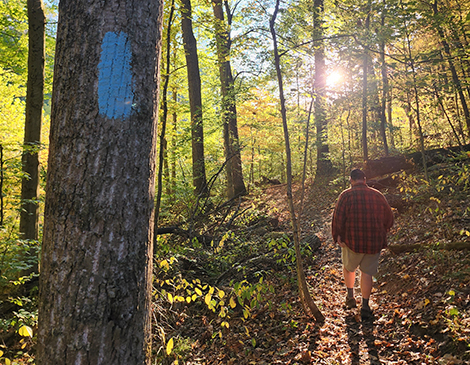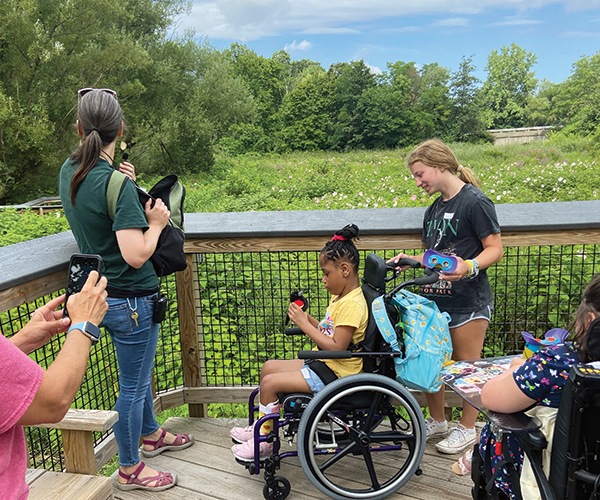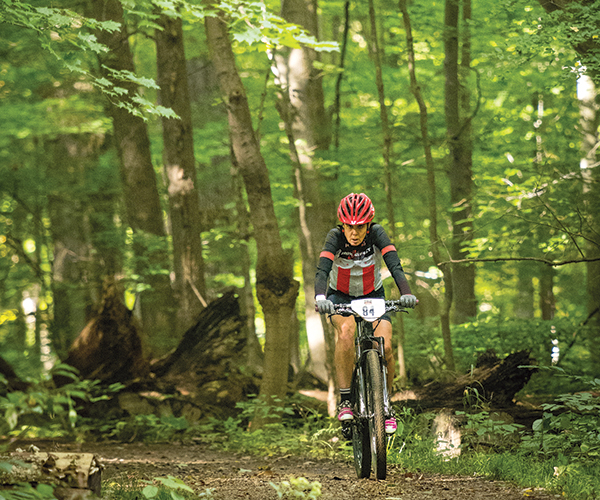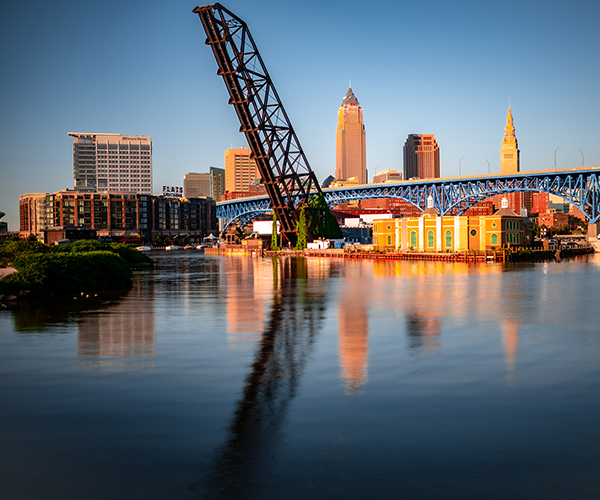Step by step, our muddy boots cross Snowville Road, trading one patch of Ohio woods for another. I’m exhausted. I shrug off my 30-pound backpack and, knees crunching, sit in the grass, while my husband, Mike, analyzes the next section of trail on a board map, dabbing at drops of forehead sweat with a handkerchief.
One section of hiking remains in the day, which will take us up and down a zig-zagging route in the Cuyahoga Valley, from Snowville Road into Brecksville Reservation. Ahead, more hills — always more hills.
The sun beams down through thick and humid air. It’s our third day of hiking, and we’re 36.3 miles deep in the 250-mile Little Loop segment of the larger 1,444-mile-long Buckeye Trail which encircles the state. The path, with its signature blue blazes, has taken us through Cuyahoga Valley National Park via the smooth Towpath Trail, and onto serpentine dirt paths in pine forests. We’ve cut through a busy city center and walked past waterfalls, markets, mobile home parks and neighborhoods.
I tighten my knee brace, take a swig of water and chomp into a granola bar. A mosquito buzzes in front of my face.
This has all been great — beautiful, jaw-dropping and exhilarating — and I’m realizing how out of shape I am.
“Whose idea was this anyway?” I ask, grumpy.
“Hah.” Mike rolls his eyes. I’ve made this joke a few times this weekend, and always when we’re tired.
Of course, this was my idea. Of course, it was for a story. It’s why we’re out here, with bruised shoulders, aching muscles and too many bug bites — and this grand adventure is happening just 30 minutes from our house.
The Buckeye Trail, Ohio’s longest trail and the nation’s longest loop trail in one state, might become more well-known. Currently, the National Park Service is conducting a feasibility study to consider it for National Scenic Trail designation.
RELATED: Into The Ohio Wild: Your Guide to Getting Outside This Fall
If approved, the massive, volunteer-run route would join 11 of the nation’s most famous trails, like the iconic Pacific Crest Trail and Appalachian Trail.
This path (or, depending on where you are, boardwalk, sidewalk or road shoulder) stitches together the state’s many parks, communities and ecologies into one squiggly hoop. And while millions of Ohioans enjoy bits of it every year, National Scenic Trail status could attract more aspirational thru-hikers who challenge themselves to complete singular, weeks-long hikes in one go. It could bring the historic trail, and Ohio, to the forefront of the nation’s hiking world.
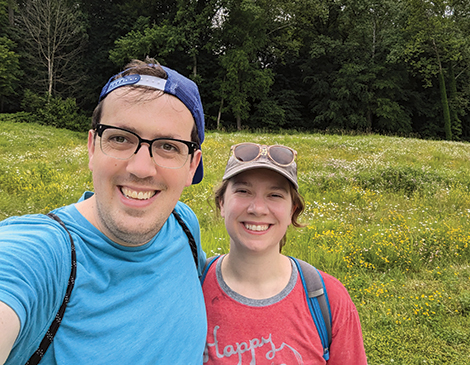
Annie Nickoloff
A muddy hiker emerges from the section of trail we’re about to start. His two dogs, panting and tails wagging, trot toward us. The hiker notices our bags and asks, incredulous, if we’re overnight backpacking. “You can do that in the national park?”
Admittedly, it’s a bit tricky. Campsites are few and far between on this specific stretch, and I’d mapped each day’s 13- to 14-mile-long segments around three spots. (It already hasn’t gone according to plan.)
But you can take a backpacking trip through Northeast Ohio, with the right prep.
We’ve got a few miles left. It’s muggy. Rain, plus a good chance of a thunderstorm, are in the forecast for the night ahead. Mike and I take another few swigs of water, then lug our heavy packs up and, step by step, tread back into the woods.
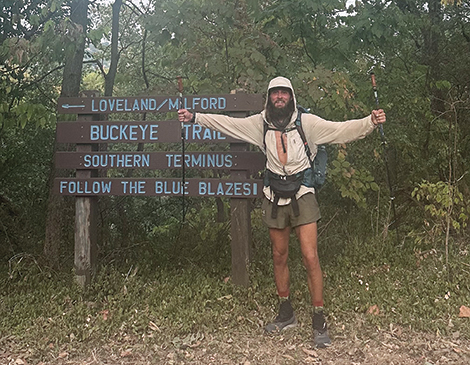
Courtesy Ian Koenig
“Keep Moving Forward” became a mantra for Ian Koenig as he took the final heavy strides of a nearly 3 million-step journey last September. As he closed in and approached a crew of family and friends at Brecksville Reservation, his hands reached out to touch and lean into the trail marker, steadying his tired and sore muscles, after 35 days, eight hours and 46 minutes on the Buckeye Trail.
Wearing a “CLEVELAND” hat, Koenig looked thin and exhausted. He cracked open a Labatt Blue Light and chomped on a well-earned burger after a journey that saw him average 40.82 miles of hiking per day.
The Cleveland native currently holds the record for the fastest known time (FKT) of a Buckeye Trail thru-hike, beating two other speed hikers: Josh Horsfall, who completed the trail in 38 days in 2021, and Everett Brandt, the first Buckeye Trail FKT hiker, who finished in 55 days in 2018.
Crossing the finish line, Koenig checks off a second accomplishment. He becomes the first hiker to do a self-supported Buckeye FKT thru-hike, carrying a pack of camping gear with him and figuring out the rest while on the trail, with no pre-planned assistance from friends or family.
Koenig, Brandt and Horsfall have seen every inch of the trail, from the pointed northern terminus at Lake Erie to the southern terminus at the Ohio River. They’ve jogged through the isolated, rolling hills of Southeastern Ohio’s Appalachian region, the historic canalways of Summit County and the burial mounds, underground railroad stops and tiny villages between major cities like Akron, Cincinnati and Dayton. They experienced the many dichotomies of Ohio: shady and sunny, wet and dry, urban and rural, historic and modern, populated and primal.
RELATED: Where to Catch the Best Fall Colors: A Leaf Peeping Guide to Cleveland and Beyond
If it becomes a National Scenic Trail, the Buckeye Trail will be the fifth longest of 12, just behind the Appalachian’s 2,190 miles. All three speed thru-hikers agree that it deserves to get the designation, which would unlock resources to advance and improve the route.
Horsfall, who has also thru-hiked the Appalachian, Continental Divide Trail and Arizona Trail, says the Buckeye Trail’s city-to-wilderness variety stands out. “It’s a different type of ‘scenic,’ but the experience is definitely worthy,” the Tallmadge resident says.
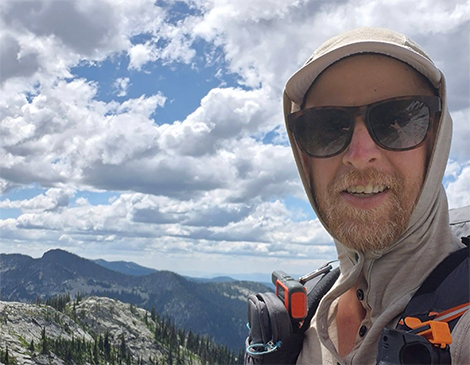
Courtesy Josh Horsfall
Koenig has thru-hiked the Appalachian and Pacific Crest trails, and says the Buckeye Trail’s length alone is just one of the reasons it should have National Scenic Trail status: “The fact that there’s a 1,500-mile loop trail in one of the most beautiful states in America that already isn’t a National Scenic Trail tends to blow my mind a little bit,” he says.
Brandt hasn’t gone on any other major long-haul thru-hikes. But he has spent quite a lot of time on the Buckeye Trail — first participating in trail challenges with his wife, and then during his monumental thru-hike, and now as one of the hundreds of volunteers who tend to the trail.
“The Buckeye Trail has been a part of every major decision I’ve made in my adult life,” Brandt says, sitting at a Rocky River Metropark picnic table, wearing a Buckeye Trail T-shirt, shorts and running shoes.
He holds up his fingers and counts off the ways the trail has altered his life’s trajectory: “Where to live. Who to marry. Name of kid.”
Where to live: Seven Hills, adjacent to the trail. Who to marry: Margaret Brandt, his outdoorsy wife, who first introduced him to backpacking. Name of kid: Miles.
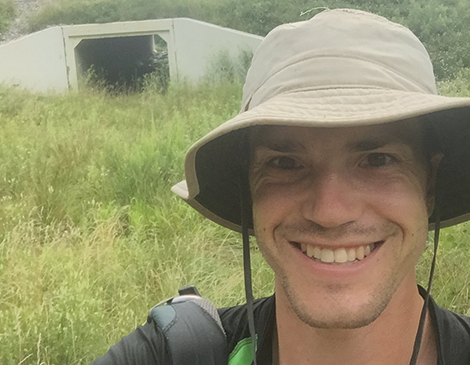
Courtesy Everett Brandt
Brandt points to one key detail about the Buckeye Trail: 900 miles of it are already a part of the lengthy North Country National Scenic Trail stretching from North Dakota to Vermont. Could the entire Ohio-specific loop also achieve National Scenic Trail status?
The feasibility study runs for three years, gathering data and input about the trail’s significance. It’s expected to finish up by spring, says Andrew Bashaw, the executive director of the Buckeye Trail Association. From there, the document will go to Congress, which could partner on authoring a bill for designation. Or it could do nothing at all.
Before this, it took years to just get Congress approval to launch the feasibility study. So much bureaucracy, and more to come. When could the Buckeye Trail join the National Scenic Trail roster?
“I hope you’re in it for the long haul,” Bashaw says.
I’m no speed-thru-hiker. Our 14 miles a day are enough to tire us out.
We take our trip with minimal preparation: too-heavy packs, not much training and crossing our fingers for good conditions. (Luck is mostly on our side with the weather, except for two heavy thunderstorms which bookend the trip.)
On Day One, the first storm makes me anxious, and I nix our plans to camp at Sand Run Metropark’s Big Bend Trailhead site. We leave our gear at home and instead turn Day One of our backpacking trip into a day hike, starting at Barberton’s Wolf Creek Trailhead for a stroll on the Towpath, which is used in many sections of the Buckeye Trail.
RELATED: 5 Northeast Ohio-Made Products To Take On Your Next Hike
Our 14-or-so miles are easy and light, passing marshy landscapes of trees and brush, old locks, historic canals and a stunning Summit Lake boardwalk. We refill our water bottles at Summit Lake Nature Center.
Not everything is so pleasant. Seemingly endless used car lots and junk yards. A noisy industrial Cargill site. Minefields of goose crap, which we carefully tiptoe around.
Ohio’s dichotomies: Beautiful and ugly, sometimes at the same time.
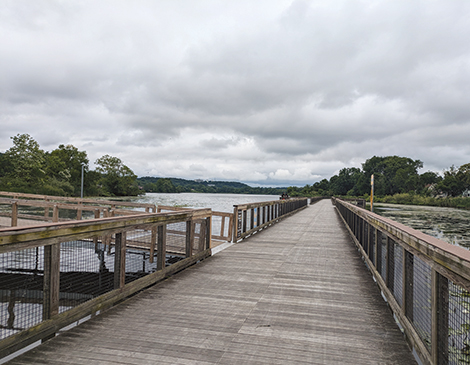
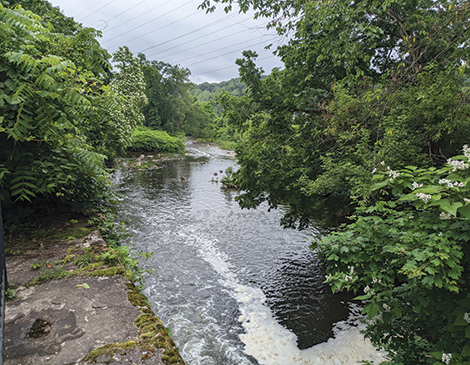
Annie Nickoloff
As the day cools, we step into the heart of Downtown Akron and the wildflower-filled Lock 3 Park, to grab dinner. Afterward, we stop on the city sidewalk and laugh at a lonely Buckeye Trail sign on a street corner, surrounded by skyscrapers. But both this concrete jungle and the scenic wooded walks are actual parts of the trail’s Little Loop of Northeast Ohio.
We watch a concert set up at Lock 3 and hear distant funk riffs as we work back into nature, eventually making our way to Sand Run, our stopping point. Bullfrog croaks fill our eardrums, and mosquitoes and gnats cloud around us. (I thank my early-morning anxiety, as we won’t have to deal with all the bugs tonight.) We grab a Lyft ride back to our car and drive home, where we sleep soundly before picking up our journey on Day Two.
The vast majority of the Buckeye Trail’s users are day-hikers, Bashaw says. More than 200 people have section-hiked the entire trail, gradually completing the entire 1,444-mile circuit over multiple years. Less than 30 people have finished the trail in one continuous hike. Even fewer have sought the ultimate challenge: to beat a thru-hiking speed record.
To move quickly means to improvise. A speed hiker aims to squeeze as many miles as possible into each day, trail running while fighting against muscle cramps, blistered toes, dehydration and both physical and mental exhaustion. They limit their pack weight, carrying few camping supplies and bare-minimum food, instead relying on restaurants, convenience stores and gas stations for meals. If embarking on a supported thru-hike, they coordinate meetups for refills and gear. If doing an unsupported thru-hike, they ship replacement materials to trail outposts. Often, they wear one outfit for the entirety of the journey. Often, they smell.
It’s not a hobby for everybody, but it’s a passion for some.
Before he decided to go on his thru-hike, Horsfall painted road lines for a living. While working in Hunting Valley, he saw his first blue blaze on a light pole, in an unremarkable road stretch of the loop.
“I was like, ‘This is a trail. I should hike this,’” says Horsfall, who was already an avid long-distance hiker. “Then I looked it up, and lo and behold, I found out it was the Buckeye Trail. And then it was three, four years later, I ended up doing that.”
Horsfall carried oatmeal, a jar of peanut butter and tuna packets for emergency meals. He used a tarp, a ground sheet, an inflatable sleeping pad and a 20-degree quilt to camp. He didn’t want to be weighed down.
“My mentality was, ‘Well, if I’m trying to go fast, I don’t want to have difficulty getting out of bed because it’s a cozy spot,’” he says.
RELATED: 4 Greater Cleveland Trails For Any Kind of Biker
When Horsfall’s trip didn’t line up with campsites, he booked rooms or sought out trail angels for help, setting up his tent on lawns or sometimes taking a generously offered guest room for the night.
But on his most desperate nights, Horsfall went stealth camping (a practice the Buckeye Trail Association is not a proponent of). Once the sun went down, he’d secretly set up camp wherever he could. Then, before the sun rose again, he’d break camp and get back to the trail.
Koenig did the same. He rattles off his many “campsites” — patches of grass behind a Wendy’s, near an interstate, in an overnight truck parking lot, behind a small town’s church and on the Buckeye Trail itself.
Koenig, who shared daily updates on his Instagram, detailed one night of stealth camping gone awry on Day 14:
I was awoken at 1AM to a truck revving by my tent at full speed. Mind you this was on a back country road where I saw no other vehicles the entire time. The truck then circled back and revved past me again. I waited to see if they left, and 20 minutes later, they revved past my tent, driving off the road almost hitting my tent, and yelling in no uncertain terms that I needed to leave. Not wanting to find out what would happen if they came back a 3rd time, I quickly packed up and hiked out. I went to a convenient store that didn’t open until 5AM and half slept outside that until they opened. Then continued with my day.
Meanwhile, many of Koenig’s other updates share stories of strangers buying meals, welcoming him into their homes and giving rides, offering help spontaneously after connecting on the trail.
Koenig wrote at the end of his trip: In a trail filled with infinite amounts of blood, sweat, and tears, there was also an immense amount of beauty. … It’s funny how fast the brain blocks out all the brutally hot days, bruised feet, exhausting nights, and spiderwebs to the face. Or maybe the beauty of the scenery, generosity of people, and the sense of adventure far outweigh those.
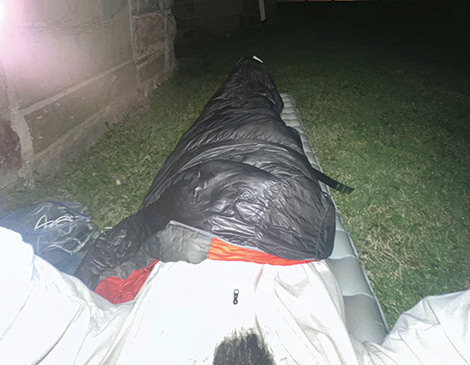
Courtesy Ian Koenig
Koenig traveled light, but in some ways, his journey was heavy. Carrying his father’s ashes with him, he spread the remains gradually in the Ohio wilderness, as he did on both the Appalachian and Pacific Crest trails. He honored his outdoors-loving dad, who died in 2023, in a way that felt fitting: scattering into the scenes he loved.
Doing this on the Buckeye Trail, so close to home — on a trail that the father and son once hiked together — brought new meaning to the tradition.
“To be able to come home to Ohio and spread his ashes on that trail where all of this really started was a really empowering idea for myself,” Koenig says.
The quiet solitude of the trail. The swish of grass and leaves. The ever-steady bird and cricket chirps. The many threads of life in Ohio gave solace and meaning, step by step, to the son.
I’ve found solace here, too. As I prepared for our backpacking journey and Koenig told me about his father, I thought of my dad. Our fall Mohican canoeing trips and winter Boston Mills skiing trips. Our summers, spent camping and biking on Kelleys Island, catching crawfish in Lorain’s creeks, swimming in Lake Erie and hiking in our backyard woods. So much life, outside. So much of it, at home in Ohio.
My dad passed last year, in early 2024. His ashes are pressed into dimpled, white cremation stones, shared among family members.
Our backpacking trip would be nowhere near as impressive as Koenig’s, Horsfall’s or Brandt’s, but it would take us deep into Northeast Ohio nature — one of the things my dad loved the most. As we gather our camping supplies, I tuck one of the stones into a side pocket of my backpack, taking this small piece of him along for the journey.
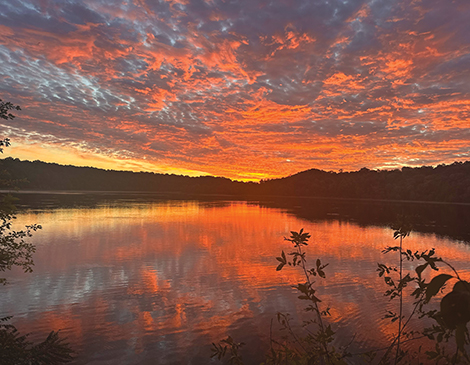
Courtesy Ian Koenig
Day Two of our hike lands on Father’s Day. Surrounded by nature, my thoughts meander around family adventures and stories, as we meander down the trail.
We meander a bit too much, get a little lost, and use the FarOut app to backtrack to the blue-blazed dirt path of O’Neill Woods. We find a steady, quiet pace, tackling the up-and-down trail in our own styles. Mike seeks out birds at Beaver Marsh for his birding app, while I jot down details in my notebook.
At Szalay’s Market, we’re sweaty, sore and happy to guzzle cups of icy lemonade and devour roasted corn on the cob. A guitarist strums the recognizable opening notes to John Denver’s “Take Me Home, Country Roads”: Almost heaven …
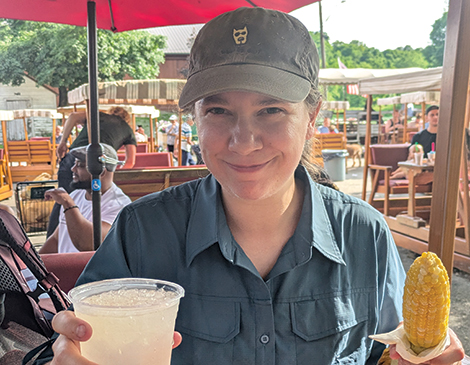
Annie Nickoloff
Families step down market rows of ripe plums and peaches, gathering and celebrating fathers on this special day in their own ways. My mind has wandered back to my dad all day, thinking about how I’ve got to call him for Father’s Day — making mental notes, reminders, feeling like it’s been too long since I’ve seen him last. The confusing sheen of loss hasn’t fully settled into the foundation of my life. Over and over, I remind myself the sad truth of it.
Throughout the day, I pat the side pocket holding my dad’s cremation stone, checking that it’s still there. Remembering.
And we continue to move forward.
From Szalay’s, we enter a dreaded section of the humid Towpath Trail where mosquitoes swarm us. I soldier on, refusing to stop for water or a rest, and after an hour of this, muscle spasms pang in my legs.
“Must. Keep. Moving,” I huff between breaths at Mike, who looks through his bag for our radio, tuning in to some classic rock station for a boost. (Bon Jovi’s “Livin’ On a Prayer” is particularly well-timed.)
We finally reach Peninsula and walk what feels like the longest-ever few blocks to Heritage Farms. Here, we drop our heavy packs into a wheelbarrow and lug them down a gravel path cutting through the idyllic Christmas tree farm landscape, to our A-frame campsite.
No bugs. What a relief.
RELATED: 5 Unique Campsites to Visit in Northeast Ohio
As we unpack, I take the white cremation stone out of my backpack first, setting it down near the firepit. I’ve still found myself accidentally cataloging all the things I’ve got to tell my Dad about: the market, the mosquitoes, the Towpath Trail and its wheelchair accessibility, this tree farm campsite we find ourselves in.
The sun sets over rows of tiny, future Christmas trees for future families to enjoy, and Mike cooks our dinner: a re-hydrated chicken teriyaki pouch. I get a fire going, like I used to on those camping trips to Kelleys Island. The cremation stone reflects the light.
We sit quietly by the flames, the two, and maybe the three, of us.
We watch as, like some kind of magic, hundreds of fireflies suddenly twinkle in the surrounding fields.
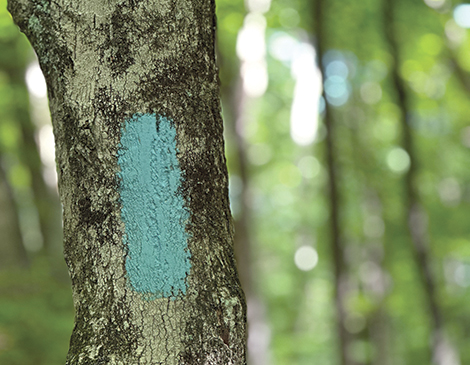
Aidan Reagh Wayne
The Buckeye Trail started as an idea, a 1958 column by writer Merrill C. Gilfillan, written under the pen name Perry Cole, in the Columbus Dispatch. What if Ohio established a great state trail, based on the success of the Appalachian Trail two decades earlier?
A year later, the Buckeye Trail Association formed to lead the effort, quickly assembling the first few hundreds of miles starting in Hocking Hills. Ohio hiker Emma “Grandma” Gatewood famously pitched in to the effort, buying some of the blue paint for marking the trail, according to the second edition of Connie and Robert Pond’s hiking and history guide Follow The Blue Blazes. Gatewood, after raising 11 children in Southern Ohio, made national headlines when she became the first woman to thru-hike the Appalachian Trail’s 2,000 miles at the age of 67. She went on to hike it two more times, along with the 2,000-mile Oregon Trail at the age of 72.
To honor her efforts in Ohio, the Buckeye Trail Association gave Gatewood a lifetime membership. It dedicated the trail’s most popular section, between Old Man’s Cave and Ash Cave in Hocking County, in her name. Every summer, the E.G.G.S. (Emma Grandma Gatewood Solstice) hike challenges hikers to take on lengthy, time-restricted treks in the woods.
Gatewood died in 1973. In the remaining decade, much of the Buckeye Trail came together. In 1980, Northeast Ohio’s Little Loop was completed, in response to internal debate over whether the Buckeye Trail should go through the city of Akron, or skirt around it and focus on nature. (“They decided to not decide,” Bashaw says, “and they went with both alternatives.”)
RELATED: National Water Trail Status Recognizes the Cuyahoga River's Great Rebound
After 50 years of running on the power of dedicated volunteers, the Buckeye Trail Association hired its first full-time employee in 2010. That’s Bashaw.
Today, the organization has a staff of three full-time employees working to strengthen existing trail systems while building new sections. Just this year, the association unveiled 9.9 new miles in Burton’s Russell Park.
If the Buckeye Trail gets National Scenic Trail status, a federal agency would administer the trail with a small staff, and the Buckeye Trail Association would likely become its official nonprofit partner, Bashaw says.
“I don’t think anybody would get rich,” Bashaw says, “but I think the Buckeye Trail would get better with increased investment.”
If, ultimately, it doesn’t get this federal boost, the Buckeye Trail will still improve — at the slower, gradual pace of volunteers, like in the past 66 years.
Those improvements are seen by the people who know the trail best.
“The Buckeye Trail is different today than when I hiked it seven years ago. There’s more camping. I’ve helped build shelters. There’s more off-road sections,” Brandt says. “There are road sections that I did, that are no longer on roads — at least 30 miles.”
RELATED: Wheelchair Musher Finds a Unique Way to Explore Northeast Ohio’s Trails
Stepping down the hard-on-the-feet berms of busy roadways are, by far, the worst bits of the Buckeye Trail. They’re a far stretch from the trail’s inspiration: the tranquil, wooded utopia of the Appalachian Trail. Yet, some of this is unavoidable on a 1,444-mile-long trail that goes through a settled, populated state like Ohio.
There’s always room for improvement, but the Buckeye Trail is, as it stands, a certifiable feat. It is the longest contiguous hiking trail in one state. It is one of the longest loop trails in the world. It traverses 49 of Ohio’s 88 counties, 18 state parks, five state forests, Wayne National Forest and Cuyahoga Valley National Park.
All of it exists largely thanks to volunteers. Bashaw estimates, on the low end, 20,000 hours of volunteer labor going toward the Buckeye Trail every year.
“It would blow people’s minds, on the amount of investment people have in that great idea: that a Buckeye Trail should go around the state for everybody to have access to Ohio’s great outdoors,” Bashaw says. “It’s just such a good idea that it kind of self-perpetuates the desire to do something to make it even better.”
The trail isn’t just about forging an impressive pathway. It’s about the Ohio communities it connects and supports.
“When people talk about the feasibility study and the national trail designation, the phrasing of volunteers, members and hikers is, ‘we’ are being considered for National Trail designation,” Bashaw says. “I find that choice of words very interesting. We are human beings, not trails, but we use them interchangeably.
“I think there’s something magical there: that the Buckeye Trail is all about the people. The people are the trail. The trail is the people.”
RELATED: 3 Trails that Help Make Northeast Ohio Nature Accessible to All
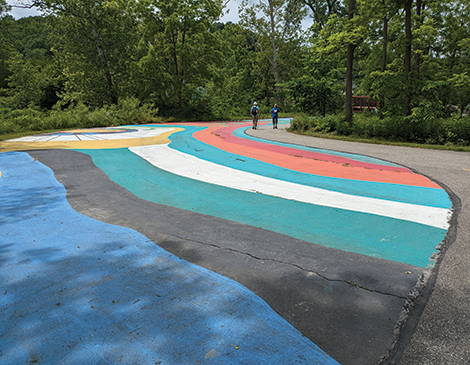
Annie Nickoloff
Mike and I study an imposing stretch of mud, testing the slick surface with our hiking poles. Day Three is our most challenging day of hiking yet. I gulp and decide to go for it, jogging down the section and, amazingly, clumsily, I slide into a clear, dry landing.
I didn’t fall into the creek. That’s a win.
As Mike navigates the mud a little more carefully, a woman in a Buckeye Trail volunteer T-shirt steps over, frowning. “I keep telling them we’ve got to fix this,” she says.
She’s one of many trail caretakers in this part of the route, located in the CVNP. Last summer, she helped to install boardwalks. The work crew carried tools and tumbled lumber down the hillside to make the necessary improvements.
Nearby, the fresh-looking boardwalk’s sign states: “Another trail structure brought to you by The Buckeye Trail Association.”
I’m glad to have them. After that storm a few days earlier, the boardwalks make these tricky, slippery riverbed sections navigable.
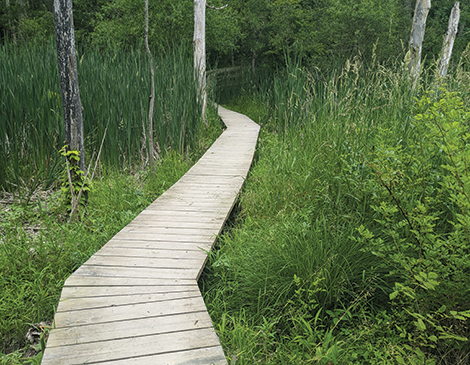
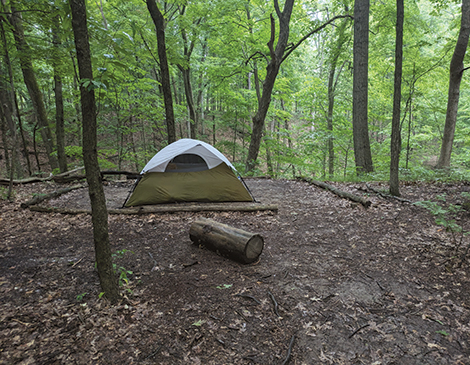
Annie Nickoloff
On Day Three, we’ve left Heritage Farms, traversed deteriorating brick roads and stunning pine forests. Blue blazes guide us through peaceful switchbacks in the woods, behind barns and along a couple of pesky roadways, then past Blue Hen Falls.
We’re huffing and puffing and occasionally sliding in the mud. Granola and fruit snacks help us fight fatigue as we pass Columbia Road, then Snowville Road.
On our last stretch, the light slowly seeps out of the sky. My anxious, meandering thoughts zero in on one remaining goal: Get to the campsite. Don’t get stuck in the woods.
The last few miles are humid, wet and dim under the canopy. As if to taunt us, a trail runner jogs by, easily trotting up one of the endless hills. This is how the speed-driven thru-hikers would have traveled — jogging, through the woods, more than a marathon, day after day, with their gear.
Where they completed 40 or more miles in a day, we’re struggling to finish the same distance in three days. I’m in awe.
Finally, as the sunlight fades away, we reach the connection to Brecksville Reservation’s Ottawa Overlook backcountry site.
A nearby restroom and water spigot are godsends. We use headlamps to make dinner and set up our tent in the quickly darkening scene. In the pitch black, we take big, hurried bites of re-hydrated mashed potatoes in near-silence.
The Little Loop’s no joke, but it pales in comparison to the remote Wilderness Loop in Southern Ohio’s Wayne National Forest.
Thru-hikers interviewed for this story name this the most challenging part of the Buckeye. There, Horsfall struggled to find a drinking water source. There, Koenig faced exhaustion, encountering 7,500 feet of elevation in a single day. There, Brandt missed a turn, losing the blue blazes in the untamed brush of wilderness, before finding his way.
Comparatively, our local Little Loop is easy. Just, maybe, not for me.
We finally hobble on aching legs to our tent, tucked on a corner of the site. We lie on top of our sleeping bags; it’s still too warm to need them. Some of my gear, including my cell phone, notebook and my dad’s cremation stone, dangles in the tent’s overhead pocket, in case of rain.
Leaves rustle as squirrels, or something else, suddenly poke around the tent. I sit up and softly clap my hands, whisper-shouting into the night.
Whatever it is, darts away. And then it’s purely, eerily quiet. An awareness settles in: We’re enveloped in the darkness on the edge of a hill in the woods.
Mike sits up. We’re quiet, both a little freaked out. We’ve hung out at the park before, but it’s never felt so noiseless.
Gazing out of the mesh window of our tent, my eyes adjust to the pitch black night and eventually pick up flickers of light — the same ones we’d seen the night before.
The fireflies return, blinking in the distance, like a procession of ghostly hikers’ headlamps, bobbing on the Buckeye Trail in between trees. A small, strange comfort in the darkness.
Eventually, I lie back down on sore muscles. Eventually, a soft patter of rain lulls me to sleep.
We originally planned to hike another day and complete 50 miles. But we wake up bright and early to a bad weather forecast: Thunderstorms. Lightning. Soon.
We decide to end our trip. (Our sore legs thank us.)
After breaking camp, we order a Lyft ride home from the nearby picnic area. Within an hour, I’m taking the hottest shower of my life and throwing our clothes into the wash.
Unpacking our bags, I first take my dad’s cremation stone out of its pocket and return it to a shelf. Maybe someday, I think, I’ll find a good spot on a trail and leave a little bit of him to rest there. Maybe, but not yet.
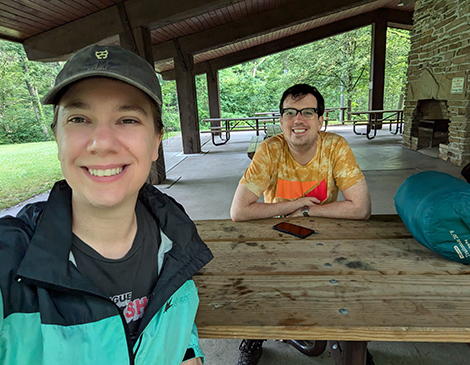
Annie Nickoloff
Within a couple of hours, as I’m drifting off into a much-needed nap, the cacaphony of a thunderstorm hammers our home’s metal awnings with a bout of heavy rain. We made the right call, nixing the last bit of adventure, after all.
As we’re recovering from our journey, on the other side of the state, a hiker named Caleb Kennelly has just begun his. He embarked on a supported thru-hike of the Buckeye Trail, tracking 44.73 miles on his first day, June 15, on Strava. Chasing after Koenig’s timing record, Kennelly tackled an impressive 960-plus miles before deciding to ditch his attempt.
He wrote on Strava: Sometimes the trail eats its young, and DNF’s (did not finish) happen! Hell is real Ohio. I’ll never forget my time on the Buckeye Trail!
For now, Koenig still holds the speed record. But he thinks it’s just a matter of time until he doesn’t.
“I look forward to people coming to break this record, and then the record getting broken again after that, and for people to continually try and continually see how amazing it is,” Koenig says. “Anyone that’s in Cincinnati or Dayton or Akron or Cleveland or Toledo — they have one of the nation’s greatest trails at their fingertips.”
Our journey was tiny compared to what thru-hikers take on. Still, I’m happy with our own imperfect, approachable introduction to backpacking one of the state’s most impressive, most beloved trails — where the adventure always continues, step by step.
For more updates about Cleveland, sign up for our Cleveland Magazine Daily newsletter, delivered to your inbox six times a week.
Cleveland Magazine is also available in print, publishing 12 times a year with immersive features, helpful guides and beautiful photography and design.

